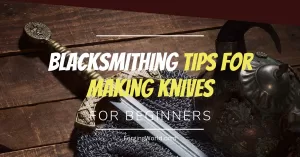My friend recently told me that he simply can’t harden his knife, no matter what. When I went to his workshop, I realized he was using mild steel. In this article, we decided to talk about the usage of mild steel for knife-making purposes.
So, should you use mild steel to make a knife?
Mild steel is not recommended for knife making, mainly due to its low-carbon content. It is almost impossible to strengthen and harden mild steel through heating and quenching. Low carbon content also results in less tensile strength which makes it inferior for knife-making purposes.
Although it is not impossible to make a knife out of it, it just won’t be a good-quality blade. Now let’s talk more about mild steel and how can you use it.
What Exactly is Mild Steel?
Mild steel is actually low-carbon steel. It is one of the most commonly used steel for construction purposes. It is strong steel and it is usually made from readily available natural materials. While high-carbon steels are preferred for knife making, mild steel contains carbon in the range of 0.05-0.25%.
It is considered the most common type of steel due to its relatively low cost, so it is typically used when a large volume of steel is required. Mild steel is very easy to work with, meaning it is easy to shape into the required shape, whether is it in hot or cold conditions.
You can find various grades of mild steel but all of them have similar carbon content. Other alloying elements are added to the mix to improve mechanical properties like tensile strength, corrosion resistance, and wear resistance.
Unlike other steels that are more brittle, mild steel is very hard but also malleable. That makes it an ideal choice for various purposes, including car manufacturing, construction materials, the construction of pipelines, and various other products. Mild steel is usually painted due to its poor corrosion resistance.
One of the most popular types of mild steel is 1018 Steel. 1018 offers a good balance of ductility, toughness, and strength. The low-carbon content found in 1018 steel makes it a highly machinable metal, meaning it can be easily formed, machined, and cut without a lot of effort. It is also known for excellent weldability but that is not so important for knife making.
Related to welding, mild steel is one of the most easily welded metals, mainly due to its low-carbon content. Keep in mind that the more strength is needed, the more carbon is added to the metal. However, the harder the steel is, the more likely it is to crack when you weld it.
As mentioned before, various other alloying elements are added to improve the chemical properties. They greatly affect both physical and chemical properties which makes them suitable for various applications but unfortunately not for knife-making. For example, added chromium has an impact on corrosion resistance and also increases the hardness of mild steel.
The carbon content of 1018 steel is somewhere between 0.14 – 0.20% which is not enough to produce a good-quality knife. The normalizing process of 1018 steel should be done at 890°C – 940°C. After heating, it should be cooled in still air.
Forging requires heating the mild steel anywhere between 1150°C – 1280°C. In case your forge can’t achieve that high temperature, 900°C is considered the minimum forging temperature. As with normalizing, after heating, it should be cooled in still air.
To temper it, you should place it in some type of oven at 150°C – 200°C to improve toughness. If properly done, the tempering process will not have any effect on the hardness. When mild steel is tempered, grinding cracks are noticeably reduced.
The annealing process is done by heating the 1018 steel at 870°C – 910°C and after that allowed to cool. Finally, to case harden this type of steel it is required to heat it somewhere between 780°C – 820°C and leave it to cool down afterward.
Can you Harden Mild Steel?
Although mild steel is low-carbon steel, it actually can be heat-treated for increasing hardness. Since carbon is the most important determinant for increasing the hardenability of steel, mild steel cannot achieve the level of hardness that a good-quality knife requires.
Mild steel can be austenitized and hardened if it were possible to cool it fast enough. That low content of carbon and a moderate amount of manganese can achieve a maximum hardness of somewhere around 40-50 Rc.
However, some people tried using a liquid called Super Quench. It is a mix of water, salt, dishwashing liquid, and surfactant. The exact recipe is down below.
Super Quench recipe
- 5 gallons (19 l) of water
- 5 lb (2.5kg) of salt
- 32 oz (950ml) of some dishwashing liquid (In case it is concentrated, then put 28 oz)
- 7-8 oz (207-236 ml) of Jet-Dry or some other surfactant
First, mix all ingredients together in a large bucket. Do it very gently, so you don’t form bubbles. After that, you have to heat the mild steel to its critical temperature. Now, it is time to sink it in and keep constant motion. If your mild steel didn’t produce a “screaming sound” it means that it wasn’t hot enough in the first place.
It is important to note that you should not temper mild steel as it will remove the hardness. With this method, you can expect to achieve hardness anywhere from 40-50 Rc. Another method is case-hardening.
Simply said, case-hardening is a type of heat-treating process that is used to produce a hard and wear-resistant outer layer. This will also preserve the interior toughness of the mild steel. That outer layer is called the case whereas the thickness is called the case depth. You can choose between several methods of case-hardening, including atmosphere carburizing, vacuum carburizing, and induction hardening.
Every method produces a different case depth and hardness of mild steel. We will show you the simpler way next which is convenient for small workshops. First, lay about 1 inch of some carbonaceous material in a steel box with a tight-fitting lid. You can use broken charcoal briquettes for this purpose, it will work well.
If you have more pieces, arrange them in a way where they don’t touch each other or the box. After that, cover the metal pieces with more charcoal briquettes by at least 1 inch. Place the fitting lid on the top of the box and fill the gaps with fire clay or refractory mortar. Put the metal box in a cold furnace and set it on around 1700°F (926°C). Leave it in a furnace to carburize for about 8 hours. As you can see, this process is used to add carbon to mild steel.
As you can see, using mild steel for making knives is not an ideal choice. Even if you manage to make a knife out of it, the edges will hold for a short while. Mild steel is simply inconsistent and unpredictable for knife-making purposes. We would definitely recommend using something like 1095 steel for starting purposes.



